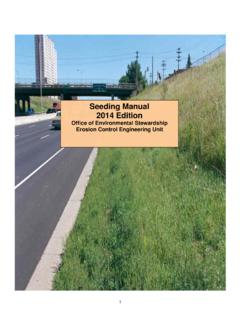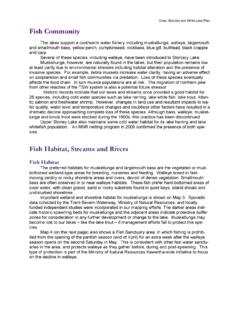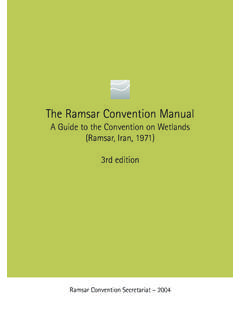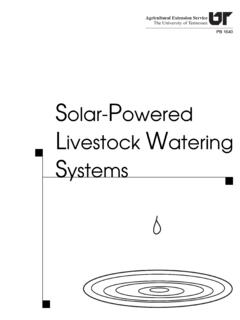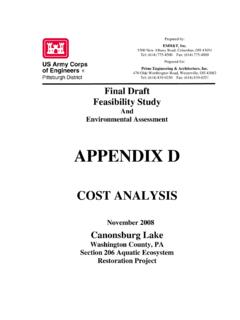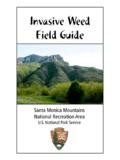Transcription of Riparian Buffer Zones: Functions and …
1 Riparian Buffer Zones: Functions and Recommended Widths Prepared by Ellen Hawes and Markelle Smith Yale School of Forestry and Environmental Studies For the Eightmile River Wild and Scenic Study Committee April 2005 2 Table of Contents 1. Function of Riparian 2. Recommended Buffer a. Erosion b. Water c. Aquatic d. Terrestrial 3. Factors Influencing Buffer a. b. Soil c. Vegetation 4. Buffer a. Variable b. Fixed c. Three 5. What Order Streams to 6. Appendix 1: Summary of Effective Buffer Widths From Literature 7.
2 Appendix 2: Other 8. Appendix 3: 9. Appendix 4: Web 3 1. Functions of Riparian Buffers Riparian buffers are vital elements of watersheds, primarily due to their protection of surface and ground water quality from impacts related to human land use. These vegetated buffers are complex ecosystems that provide food and habitat for unique plant and animal species, and are essential to the mitigation and control of nonpoint source pollution. In fact, the removal of streamside vegetation, primarily for development purposes, has resulted in degraded water resources and diminished value for human consumption, recreation, and industrial In the Eightmile River watershed, maintenance of Riparian buffers in their natural condition has been identified as one of the most effective means of protecting multiple outstanding resource values (ORVs)
3 , including water quality, hydrology, unique species and natural communities, and watershed ecosystem function. Sedimentation increases turbidity and contributes to rapid siltation of waterbodies, negatively impacting water quality. Increased sediment loads also narrow channel widths and provide substrate for colonization of invasive aquatic plant species. Intact Riparian buffers ameliorate these negative impacts by stabilizing streambanks. Roots of Riparian vegetation deflect wave action and hold bank soil together.
4 The Buffer vegetation also decreases erosional impacts during flood events and prevents undercutting of streambanks. Excess nitrogen and phosphorous from fertilizers and animal waste, as well as other pollutants originating from pesticides and herbicides, often bond to soil particles. The nutrient-loaded sediment contained in surface runoff then flows to the nearest waterbody and is deposited. This process is the primary cause of accelerated eutrophication of lakes and rivers2. Streamside forests function as filters, transformers, and sinks for harmful nutrients and pollutants3.
5 Buffer plants slow sediment-laden runoff and depending upon their width and vegetational complexity, may deposit or absorb 50 to 100% of sediments as well as the nutrients and pollutants attached to them4. When surface water runoff is filtered by the Riparian Buffer approximately 80 to 85% of phosphorous is captured5. Nitrogen and other pollutants can be transformed by chemical and biological soil activity into less harmful substances. In addition, Riparian plants act as sinks, absorbing and storing excess water, nutrients, and pollutants that would otherwise flow into the river, reducing water quality.
6 One of the most important Functions of Riparian buffers is enhanced infiltration of surface runoff6. Riparian vegetation in the Buffer surrounding a waterbody increases surface roughness and slows overland flows. Water is more easily absorbed and allows for groundwater recharge. These slower flows also regulate the volume of water entering rivers and streams, thereby minimizing flood events and scouring of the streambed. 1 Welsch 1991 2 Jontos 2004 3 Welsch 1991 4 Connecticut River Joint Commission 2005 5 Connecticut River Joint Commission 2005 6 Dillaha et al.
7 1989 4 Many plant and animal species depend on the distinctive habitat of Riparian buffers, which include elements of both terrestrial and aquatic ecosystems. Forested buffers improve habitat quality by providing shade that cools water temperatures, thereby elevating the dissolved oxygen content that is necessary for many species of fish and aquatic insects. Woody debris from shrubs and trees within the vegetated Buffer provides food and cover for a multitude of aquatic species.
8 If large enough, buffers also provide corridors essential for terrestrial wildlife movement. Vegetated buffers may serve as screens along waterways, protecting the privacy of riverfront landowners and blocking views of any unsightly development. Hiking and camping opportunities are also facilitated by forested buffers, which if large enough, allow outdoor enthusiasts to enjoy the proximity of the water. The diversity of plant species provides visual interest and increases aesthetic appeal. 2. Recommended Buffer widths The width of a Buffer depends greatly on what resource you are trying to protect.
9 Scientific studies have shown that efficient Buffer widths range from 10 feet for bank stabilization and stream shading, to over 300 feet for wildlife habitat. Furthermore, the necessary width for an individual site may be less or more than the average recommendations, depending on soil type, slope, land use and other factors. The ranges cited below come from four literature reviews by The Army Corps of Engineers New England Division, the University of Georgia s Institute of Ecology, the Army Engineer Research and Development Center, and researchers from the UK Forestry Results from studies done in New England fall within the ranges cited below, and no evidence was found in the literature to suggest that buffers should be, on average, either wider or narrower.
10 A. Erosion control Erodibility of soil type is a key factor when assessing adequate Buffer widths. Widths for effective sediment removal vary from only a few feet in relatively well drained flat areas to as much as several hundred feet in steeper areas with more impermeable soils. In order to prevent most erosion, vegetated buffers of 30 feet to 98 feet have been shown to be effective. b. Water quality Nutrients - Nitrogen and phosphorous can be retained in buffers that range from 16 to 164 feet. The wider buffers will be able to provide longer-term storage.

